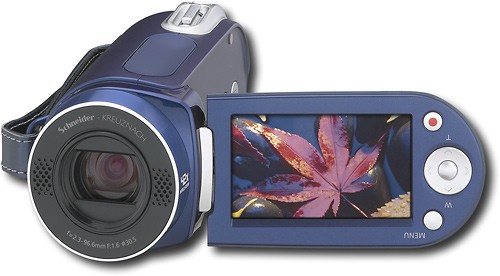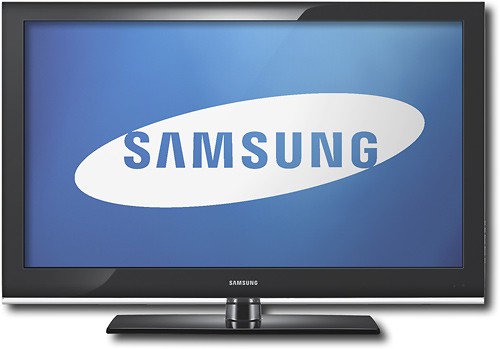MrSamsung
MrSamsung's Stats
Reviews
- Review Count0
- Helpfulness Votes0
- First ReviewNone
- Last ReviewNone
- Featured Reviews0
- Average Rating0
Reviews Comments
- Review Comment Count0
- Helpfulness Votes0
- First Review CommentNone
- Last Review CommentNone
- Featured Review Comments0
Questions
- Question Count0
- Helpfulness Votes0
- First QuestionNone
- Last QuestionNone
- Featured Questions0
- Answer Count1815
- Helpfulness Votes1,621
- First AnswerJune 2, 2009
- Last AnswerApril 22, 2013
- Featured Answers0
- Best Answers225
MrSamsung's Reviews
MrSamsung has not submitted any reviews.
MrSamsung's Questions
MrSamsung has not submitted any questions.

Samsung - Digital Camcorder with 2.7" Color LCD Monitor - Blue
Capture video directly to Secure Digital cards or the built-in memory with this powerful camcorder that features a 34x optical zoom and digital image stabilization.
Want to buy a fish eye lens for this camera what size is compatible?
I am interested in buying a fish eye lens. The Opteka OP-5C37FE lens says it will fit a 25mm, 30mm, 30.5 mm, 37mm lens. Will this fit my new camcorder SMZ-F34LNNTSC??
Thanks for the question. From the info I have, it seems that 3rd party lenses are either bolt on or screw on. That being the case, they will not be supported by the SMX-F34LN. This unit, along with most of the Samsung camcorders, only offer the on-unit lenses and will not accept 3rd party lenses.
-MrSamsung
-MrSamsung
14 years, 10 months ago
by
Posted by:
MrSamsung
from
SamsungHQ

Samsung - 40" Class / 1080p / 60Hz / LCD HDTV
With a brilliant 1080p display, 60,000:1 dynamic contrast ratio and multiple HDMI inputs, this HDTV provides a stunning focus for your multimedia center.
Can you use a "Cable Card" with this tv or do you have to get the HD Box?
Unfortunately, all current consumer model Samsung TVs do not offer a cablecard connection. Due to the ever changing format and standards by the cable companies in regards to cablecards, the technology has been put on hold and then replaced by more accessible technologies.
-MrSamsung
-MrSamsung
14 years, 10 months ago
by
Posted by:
MrSamsung
from
SamsungHQ

Samsung - 40" Class / 1080p / 60Hz / LCD HDTV
With a brilliant 1080p display, 60,000:1 dynamic contrast ratio and multiple HDMI inputs, this HDTV provides a stunning focus for your multimedia center.
What format ratios are available on this TV (full screen, zoom, etc.)?
Thanks for the question! I would be happy to help you out with this. Most Samsung TVs offer these aspect ratios: 16:9, 4:3, Zoom, Fit to Screen, and Wide Fit. In order to change the aspect ratio (screen size), you will want to head into the TV's menu, then to the picture sub-menu. Once there, head into the "Picture Options" option. Within that option, you will see the "Size" adjustment. Clicking into that will allow you to change the picture size of the screen. Please note: some of these options may be grayed out depending on the connection type you are using.
-MrSamsung
-MrSamsung
14 years, 10 months ago
by
Posted by:
MrSamsung
from
SamsungHQ

Samsung - 40" Class / 1080p / 60Hz / LCD HDTV
With a brilliant 1080p display, 60,000:1 dynamic contrast ratio and multiple HDMI inputs, this HDTV provides a stunning focus for your multimedia center.
Can I hear the 3.5mm audio input while viewing an HDMI input?
I have a laptop I wish to connect to the TV that has HDMI and 3.5mm audio out, and doesn't support audio over HDMI.
Great question! When connecting your laptop to the TV via the HDMI connection, please make sure that you have it connected in the HDMI1(DVI) input. This will allow you to connect your laptop's audio to the red/white RCA DVI audio in jacks located right next to the HDMI1(DVI) input. This will be the only audio input that will allow for the audio from the HDMI1 source to be played on the TV. Please note, you will want to use a 3.5mm to RCA red/white connector cable for this application.
-MrSamsung
-MrSamsung
14 years, 10 months ago
by
Posted by:
MrSamsung
from
SamsungHQ

Samsung - 40" Class / 1080p / 60Hz / LCD HDTV
With a brilliant 1080p display, 60,000:1 dynamic contrast ratio and multiple HDMI inputs, this HDTV provides a stunning focus for your multimedia center.
How to hook up my current surround sound to this particular model?
What's the best way hooking up a receiver to your TV for surround sound on this particular model? I currently have an hd box running to the only 3 component inputs on the back? Do I need an hdmi receiver? The receiver I currently have doesn't have hdmi inputs or outputs. Would I have to directly run the 3 cables from my hd cable box directly to the receiver than to the TV? Is there anything else I would need to purchase to use the surround system I currently own?
Thanks for the question. As a matter of fact, the method you mentioned is one of 2 different ways you can connect your TV to the receiver. Another way, and probably the easiest way, is to keep all of your devices connected to the TV, then run either an RCA red/white cable or optical cable from the rear of the TV (where the audio outputs are located) to the receiver. This will allow your devices to be viewed from your TV and have the audio sent to the receiver with minimal hook ups.
-MrSamsung
-MrSamsung
14 years, 10 months ago
by
Posted by:
MrSamsung
from
SamsungHQ

Samsung - 40" Class / 1080p / 60Hz / LCD HDTV
With a brilliant 1080p display, 60,000:1 dynamic contrast ratio and multiple HDMI inputs, this HDTV provides a stunning focus for your multimedia center.

Samsung - 40" Class / 1080p / 60Hz / LCD HDTV
With a brilliant 1080p display, 60,000:1 dynamic contrast ratio and multiple HDMI inputs, this HDTV provides a stunning focus for your multimedia center.
Can I use a Universal Remote?
I am buying this TV for my inlaws who both need to have their own remote. Will a universal remote work with this television?
Thanks for the question. Although a universal remote should work just fine with the LN40B530, I would suggest that you review the manual for the remotes to make sure that Samsung TV codes are available to be inputted. Also, check the remote manufacturer's online site for updates on codes. Due to some manufacturers using different codes for their IR remotes, Samsung does not have access to the universal codes for the remotes.
-MrSamsung
-MrSamsung
14 years, 10 months ago
by
Posted by:
MrSamsung
from
SamsungHQ

Samsung - 40" Class / 1080p / 60Hz / LCD HDTV
With a brilliant 1080p display, 60,000:1 dynamic contrast ratio and multiple HDMI inputs, this HDTV provides a stunning focus for your multimedia center.
can tv connect to the internet?
is this tv capable of connecting to the internet to download movies?

Samsung - 40" Class / 1080p / 60Hz / LCD HDTV
With a brilliant 1080p display, 60,000:1 dynamic contrast ratio and multiple HDMI inputs, this HDTV provides a stunning focus for your multimedia center.
Which is better, a plasma screen or LCD screen?
A common question among consumers is how Plasma Technology differs from LCD Technology.
Both provide an excellent HD picture, offer stunning arrays of colors, and of course, Samsung’s exclusive technologies which allow you to get the most out of either panel.
LCD traditionally uses a CCFL (Cold Cathode Fluorescent Lamp) backlighting system that runs across the rear internal portion of the unit to illuminate the LCD panel from behind (however, the Samsung LED Televisions use LEDs for its backlighting unit). The lamp life is estimated up to 100 thousand hours, enjoys a tremendous following of enthusiasts, and translates into years of enjoyment of an affirmed, reliable and trusted technology.
Plasma Televisions operate using a combination of gas and glass to illuminate the individual pixels, or light sections, within the screen. The life of a plasma panel is up to 100 thousand hours, allows an expanded viewing angle over LCD, and has a response time as fast as .001ms. Some models are also capable of 3-D video. All of the Samsung Plasma units have a feature called Screen Burn Protection, which helps reduce the effects of static images and provide a quality image for the life of the panel.
Conventional LCD Televisions offer a great picture without image-retention and smooth image motion using the Auto Motion Plus processing. Plasma Televisions offer faster response times, future abilities for 3-D experiences, as well as appeals to customers replacing a tube television with a glass screen they are familiar and comfortable with. And, due to advances in technology, both plasma and LCD screens can work well even in the brightest rooms.
-MrSamsung
Both provide an excellent HD picture, offer stunning arrays of colors, and of course, Samsung’s exclusive technologies which allow you to get the most out of either panel.
LCD traditionally uses a CCFL (Cold Cathode Fluorescent Lamp) backlighting system that runs across the rear internal portion of the unit to illuminate the LCD panel from behind (however, the Samsung LED Televisions use LEDs for its backlighting unit). The lamp life is estimated up to 100 thousand hours, enjoys a tremendous following of enthusiasts, and translates into years of enjoyment of an affirmed, reliable and trusted technology.
Plasma Televisions operate using a combination of gas and glass to illuminate the individual pixels, or light sections, within the screen. The life of a plasma panel is up to 100 thousand hours, allows an expanded viewing angle over LCD, and has a response time as fast as .001ms. Some models are also capable of 3-D video. All of the Samsung Plasma units have a feature called Screen Burn Protection, which helps reduce the effects of static images and provide a quality image for the life of the panel.
Conventional LCD Televisions offer a great picture without image-retention and smooth image motion using the Auto Motion Plus processing. Plasma Televisions offer faster response times, future abilities for 3-D experiences, as well as appeals to customers replacing a tube television with a glass screen they are familiar and comfortable with. And, due to advances in technology, both plasma and LCD screens can work well even in the brightest rooms.
-MrSamsung
14 years, 10 months ago
by
Posted by:
MrSamsung
from
SamsungHQ

Samsung - Digital Camcorder with 2.7" Color LCD Monitor - Blue
Capture video directly to Secure Digital cards or the built-in memory with this powerful camcorder that features a 34x optical zoom and digital image stabilization.